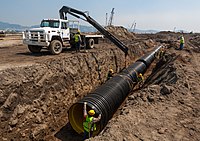
Photo from wikipedia
Abstract. In the southwestern coastal region of Bangladesh, options for drinking water are limited by groundwater salinity. To protect and improve the drinking water supply, the large variation in groundwater… Click to show full abstract
Abstract. In the southwestern coastal region of Bangladesh, options for drinking water are limited by groundwater salinity. To protect and improve the drinking water supply, the large variation in groundwater salinity needs to be better understood. This study identifies the palaeo and present-day hydrological processes and their geographical or geological controls that determine variation in groundwater salinity in Upazila Assasuni in southwestern Bangladesh. Our approach involved three steps: a geological reconstruction, based on the literature; fieldwork to collect high-density hydrological and lithological data; and data processing to link the collected data to the geological reconstruction in order to infer the evolution of the groundwater salinity in the study area. Groundwater freshening and salinization patterns were deduced using PHREEQC cation exchange simulations and isotope data were used to derive relevant hydrological processes and water sources. We found that the factor steering the relative importance of palaeo and present-day hydrogeological conditions was the thickness of the Holocene surface clay layer. The groundwater in aquifers under thick surface clay layers is controlled by the palaeohydrological conditions prevailing when the aquifers were buried. The groundwater in aquifers under thin surface clay layers is affected by present-day processes, which vary depending on present-day surface elevation. Slightly higher-lying areas are recharged by rain and rainfed ponds and therefore have fresh groundwater at shallow depth. In contrast, the lower-lying areas with a thin surface clay layer have brackish–saline groundwater at shallow depth because of flooding by marine-influenced water, subsequent infiltration and salinization. Recently, aquaculture ponds in areas with a thin surface clay layer have increased the salinity in the underlying shallow aquifers. We hypothesize that to understand and predict shallow groundwater salinity variation in southwestern Bangladesh, the relative elevation and land use can be used as a first estimate in areas with a thin surface clay layer, while knowledge of palaeohydrogeological conditions is needed in areas with a thick surface clay layer.
Journal Title: Hydrology and Earth System Sciences
Year Published: 2019
Link to full text (if available)
Share on Social Media: Sign Up to like & get
recommendations!